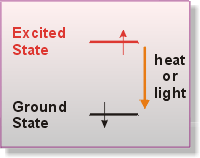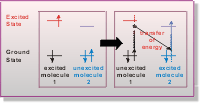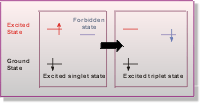Lesson Outline
Lesson Media Objects
|
The Interaction of Light with Biological Molecules De-excitation Pathways
 |
|
Decay: As an excited electron falls back to its ground state, heat or light can be given off. In the process of fluorescence, the electron drops from the excited state back to the ground state by emitting a photon. This emitted second photon is different from the absorbed photon because some energy is lost in the process, so it has a longer wavelength than the initial photon. |
Alternately, it is possible for an excited electron to drop back to the ground state by converting the energy to heat. This process of losing the excitation energy as heat is often called quenching. Another mechanism for de-excitation is energy transfer to a second pigment molecule (Figure: Electron Transfer).
 |
|
Electron Transfer: As an excited electron falls back to its ground state, it’s energy can be transferred to an electron of another molecule. |
If two molecules are sufficiently close to one another and their conjugated double-bond systems are properly oriented, the energy from the excited electron in the first pigment may be transferred to an electron in the second pigment molecule. Because small amounts of energy can be lost by molecular vibration between the initial absorption and the transfer, the second pigment molecule has a slightly smaller amount of energy than the first molecule. Because of this energy loss, transfer between the two pigments is unidirectional.
The above examples, involving an excited electron with a spin opposite to the electron in the ground state are called singlet states. Sometimes the spin on an excited electron can undergo a ’flip’. This is a normally forbidden process and occurs infrequently. However, when this does happen, the electron is moved to a new orbital with lower energy called the triplet state (Figure: Triplet State).
 |
|
Triplet State: When an ecited electron changes the direction of its spin, it drops to a slightly lower energy state. This striplet state can cause biological damage. |
Once in the triplet state, the electron must remain there until there is a second flip to reverse the spin on the electron again. Because electron spin flips are rare, triplet states can last a very long time in biochemical terms (even as long as a second). Once the electron in the triplet state does undergo a flip, the energy may be lost as a photon in a manner similar to fluorescence. However this emitted photon is at a longer wavelength than photons derived from fluorescence de-excitation and are called phosphorescence. As will be described next, triplet state excited molecules are capable of causing biological damage. Before going to that topic, though, CLICK HERE for a visual animation depicting the electron concepts just discussed. |
|
Comments